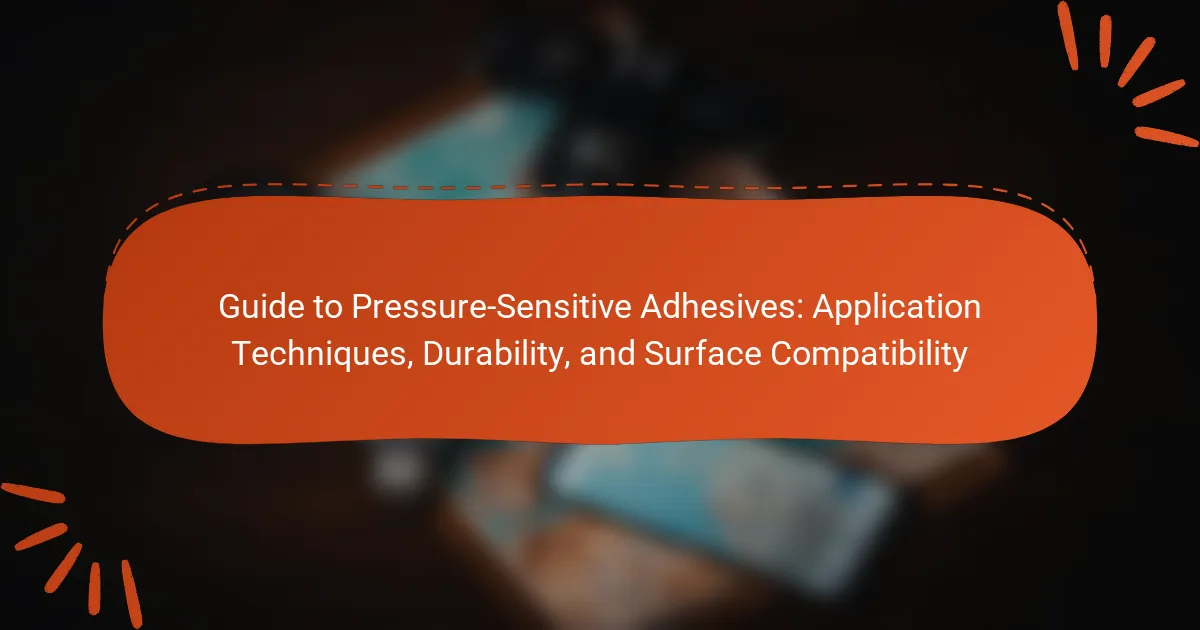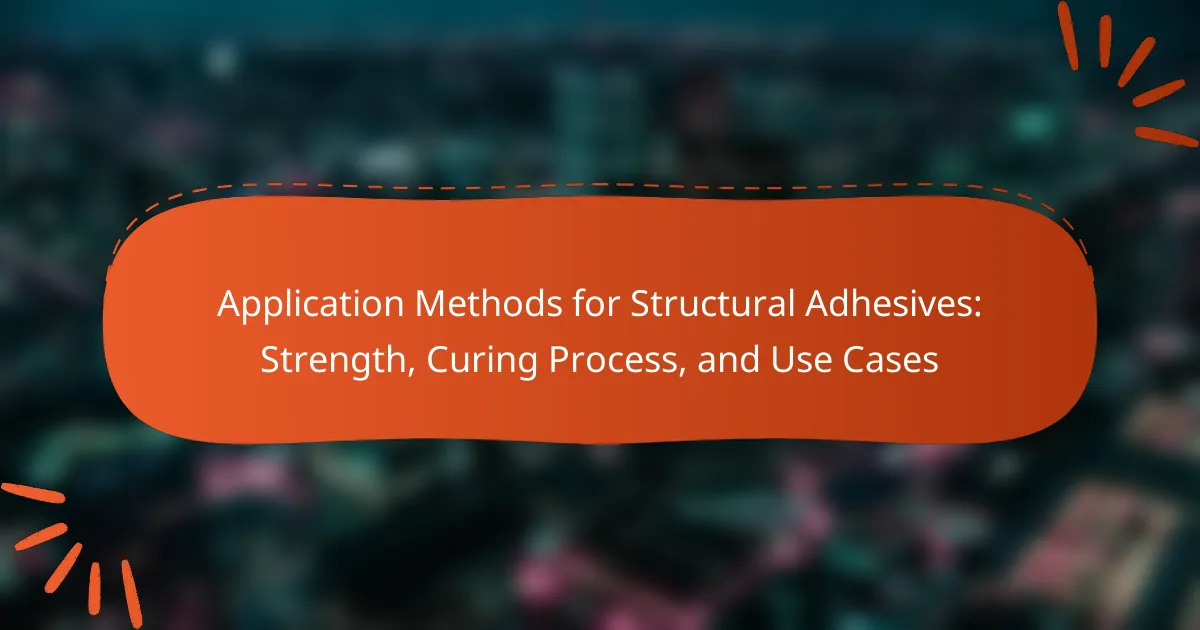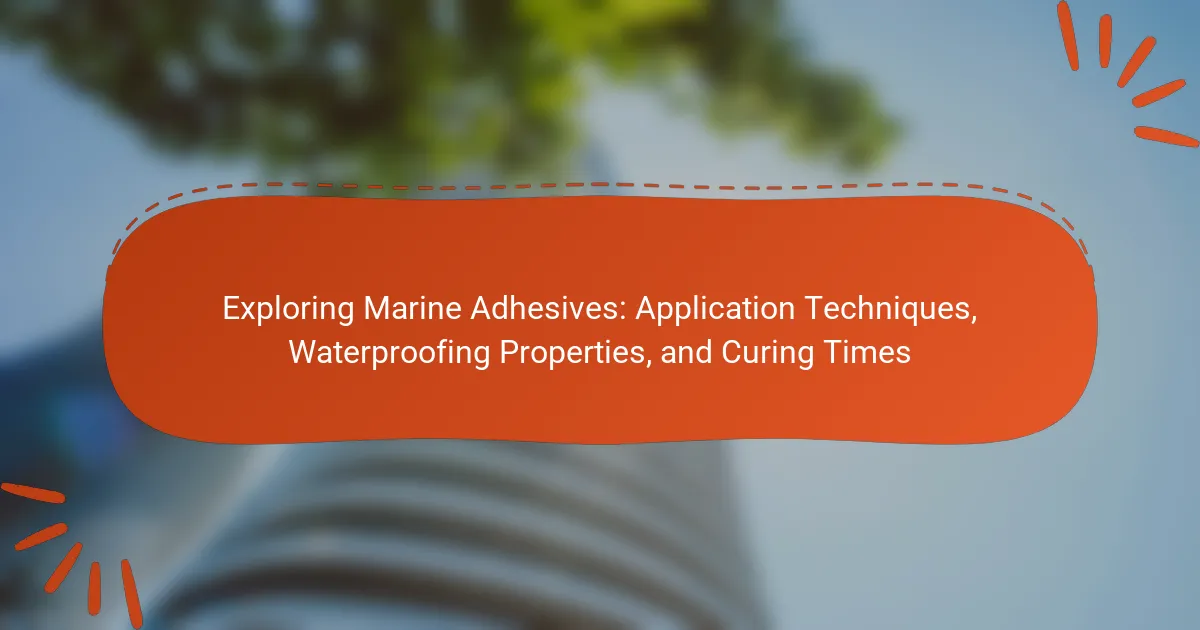Pressure-sensitive adhesives (PSAs) are adhesive substances that bond to surfaces through applied pressure without requiring heat or solvents. This article provides a comprehensive guide on PSAs, detailing their application techniques, durability, and compatibility with various surfaces. Key topics include the importance of surface preparation, consistent pressure application, and proper alignment for optimal adhesion. Additionally, the article explores the durability of PSAs based on their formulation and environmental factors, as well as how surface energy and texture influence bonding effectiveness. By understanding these aspects, users can enhance the performance and longevity of pressure-sensitive adhesives in diverse applications.
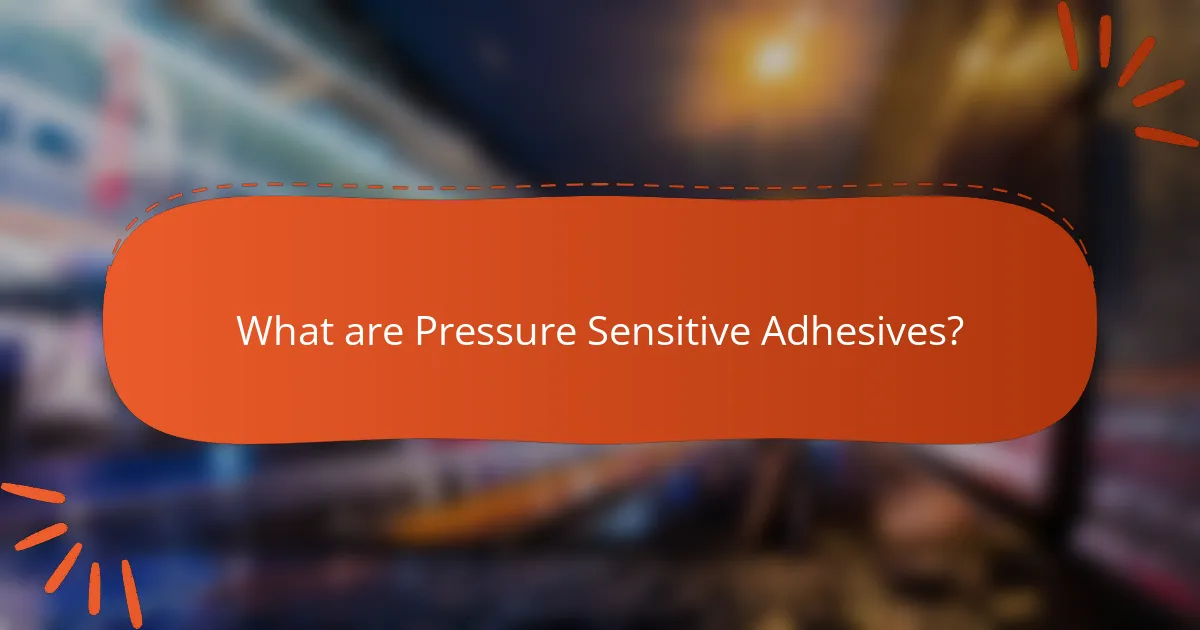
What are Pressure-Sensitive Adhesives?
Pressure-sensitive adhesives (PSAs) are adhesive substances that bond to surfaces when pressure is applied without the need for heat or solvents. PSAs are commonly used in products like tape, labels, and medical dressings. They exhibit tackiness at room temperature and can form a bond with various substrates. This bonding occurs upon contact, allowing for easy repositioning and removal. PSAs are formulated from polymers such as acrylics, rubber, or silicone. Their versatility makes them suitable for diverse applications across industries. The ease of use and immediate adhesion are key advantages of pressure-sensitive adhesives.
How do Pressure-Sensitive Adhesives work?
Pressure-sensitive adhesives (PSAs) work by forming a bond upon application of light pressure. They do not require heat or solvent activation to adhere to surfaces. PSAs are typically made from polymers that exhibit viscoelastic properties. This allows them to flow slightly and conform to the surface texture of the materials they adhere to.
When pressure is applied, the adhesive flows into the microscopic pores of the substrate. This creates a mechanical interlock that enhances adhesion. The bond strength can be influenced by the type of polymer used and the surface energy of the materials involved.
PSAs are widely used in various applications, including tapes, labels, and medical devices. Their effectiveness is often determined by factors such as temperature, humidity, and the nature of the surfaces being bonded.
What are the key components of Pressure-Sensitive Adhesives?
The key components of pressure-sensitive adhesives (PSAs) are polymeric materials, tackifiers, and additives. Polymeric materials provide the primary adhesive properties. Common polymers used include acrylics, rubber, and silicone. Tackifiers enhance the stickiness and improve adhesion to surfaces. Additives can modify the properties of the adhesive, such as improving UV resistance or thermal stability. Each component plays a crucial role in determining the performance and application of PSAs.
How do the components influence adhesion properties?
Components significantly influence adhesion properties by determining the interaction between adhesive and substrate. The chemical composition affects surface energy and wetting ability. Higher surface energy materials tend to promote better adhesion. Additionally, additives like tackifiers enhance initial stickiness. Fillers can modify the viscosity and flexibility of the adhesive. These changes impact how well the adhesive bonds under stress. For example, a study found that specific polymer blends improved adhesion strength by 30%. This demonstrates the critical role of components in achieving effective adhesion.
What are the different types of Pressure-Sensitive Adhesives?
There are several types of pressure-sensitive adhesives (PSAs). The main categories include acrylic, rubber, and silicone adhesives. Acrylic adhesives offer excellent UV resistance and are commonly used in outdoor applications. Rubber adhesives provide strong initial tack and are often used for general-purpose bonding. Silicone adhesives have high-temperature resistance and are suitable for specialized applications. Each type of PSA has unique properties that make it suitable for different uses. For example, acrylic PSAs are known for their durability and long-term performance. Rubber PSAs are favored for their quick bonding capabilities. Silicone PSAs excel in extreme temperature conditions.
What are the categories based on chemical composition?
The categories based on chemical composition for pressure-sensitive adhesives include acrylics, rubber-based adhesives, and silicone adhesives. Acrylic adhesives are known for their excellent UV resistance and durability. Rubber-based adhesives offer strong initial tack and are often used for general bonding applications. Silicone adhesives provide high-temperature resistance and flexibility. These categories are defined by the specific chemical structures and properties that influence their performance in various applications.
How do different types affect application methods?
Different types of pressure-sensitive adhesives (PSAs) significantly influence application methods. Each type, such as rubber-based, acrylic, and silicone PSAs, has unique properties affecting adhesion and performance. Rubber-based adhesives typically offer excellent initial tack and are suitable for quick bonding applications. Acrylic adhesives provide superior UV resistance and durability, making them ideal for outdoor use. Silicone adhesives excel in high-temperature environments and maintain flexibility over time. The choice of adhesive type determines the surface preparation needed, the application technique used, and the curing time required. For instance, rubber-based adhesives may require less surface preparation compared to acrylics, which often need clean, dry surfaces for optimal bonding.
What are the primary applications of Pressure-Sensitive Adhesives?
The primary applications of Pressure-Sensitive Adhesives (PSAs) include bonding, mounting, and sealing. PSAs are widely used in the automotive industry for attaching trim and components. They are also essential in the packaging sector for labels and tapes. In electronics, PSAs are applied for securing components and displays. The medical field utilizes PSAs in wound dressings and transdermal patches. PSAs are favored for their ability to bond without requiring heat or solvents. Their versatility allows use on various substrates, including plastics, metals, and paper. According to a report by Smithers Pira, the global PSA market is projected to grow significantly, indicating their increasing applications across industries.
Which industries commonly use Pressure-Sensitive Adhesives?
The industries that commonly use pressure-sensitive adhesives (PSAs) include automotive, electronics, packaging, and construction. In the automotive industry, PSAs are utilized for bonding interior components and securing trims. Electronics manufacturers apply PSAs for attaching screens and components. The packaging industry uses PSAs for labels and seals. In construction, PSAs are employed for flooring and wall coverings. Each of these industries benefits from the versatility and ease of application of PSAs.
How do Pressure-Sensitive Adhesives enhance product performance?
Pressure-sensitive adhesives enhance product performance by providing strong, immediate bonding without the need for heat or solvents. They offer a reliable adhesion that can withstand various environmental conditions. This type of adhesive allows for easy application and repositioning, which increases efficiency during manufacturing. Their versatility enables use on different substrates, improving compatibility across materials. Pressure-sensitive adhesives also contribute to reduced assembly times, leading to cost savings. Additionally, they can improve product durability by maintaining bond integrity over time. Studies show that products using these adhesives experience fewer failures in performance, confirming their effectiveness in enhancing overall quality.
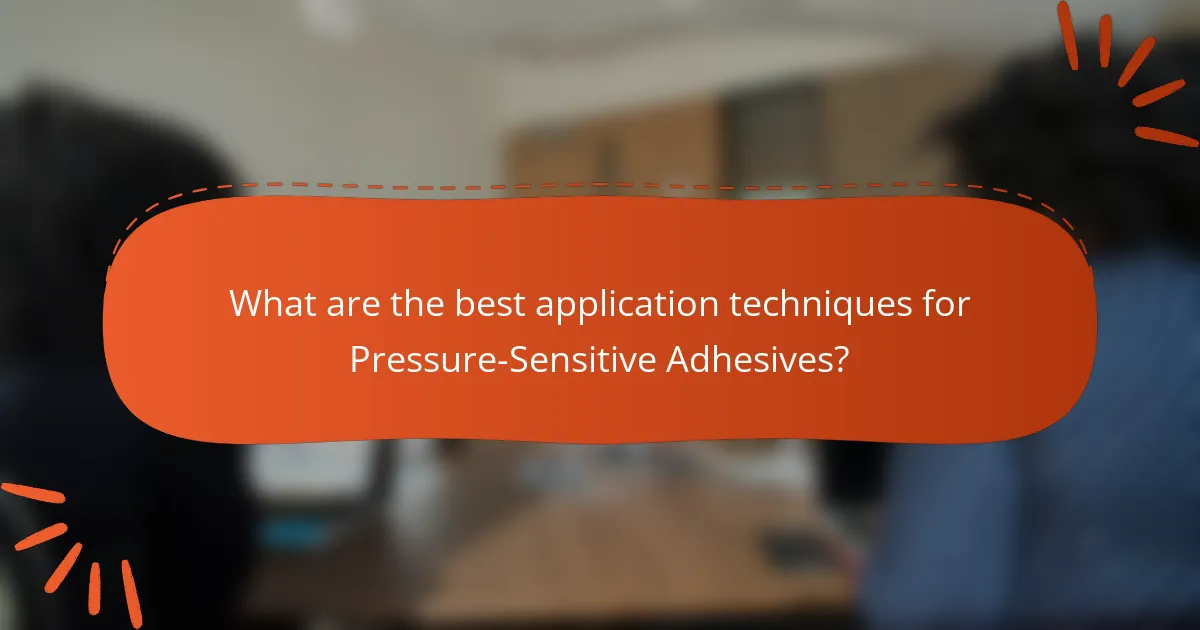
What are the best application techniques for Pressure-Sensitive Adhesives?
The best application techniques for pressure-sensitive adhesives include surface preparation, consistent pressure application, and proper alignment. Surface preparation involves cleaning and drying the substrate to ensure optimal adhesion. Consistent pressure application helps to create a strong bond by ensuring the adhesive makes full contact. Proper alignment is crucial to avoid misplacement, which can compromise the adhesive’s effectiveness.
Using a roller or squeegee can enhance pressure application. These tools help distribute the adhesive evenly across the surface. Additionally, applying the adhesive at the recommended temperature can improve performance. Research indicates that temperature affects the initial tack and final bond strength of pressure-sensitive adhesives.
Following manufacturer guidelines for curing time and conditions also maximizes adhesive performance. Adhering to these techniques leads to better durability and effectiveness of the adhesive in various applications.
How should Pressure-Sensitive Adhesives be applied for optimal results?
Pressure-sensitive adhesives should be applied with even pressure and proper surface preparation for optimal results. Clean the surface to remove dust, grease, and contaminants. Use a roller or squeegee for uniform application. Ensure the adhesive is at room temperature for better flow. Apply the adhesive in a controlled manner to avoid air bubbles. Allow adequate curing time as specified by the manufacturer. Proper application maximizes adhesion strength and durability. Studies indicate that following these methods can enhance bonding effectiveness significantly.
What surface preparation is necessary before application?
Surface preparation is crucial before applying pressure-sensitive adhesives. The surface must be clean, dry, and free from contaminants. This includes removing dust, grease, oil, and moisture. A clean surface ensures optimal adhesion and performance of the adhesive. Additionally, roughening the surface can enhance bonding. This can be achieved through sanding or using a suitable abrasive. Proper surface preparation increases the durability and effectiveness of the adhesive application.
What are the recommended application methods?
The recommended application methods for pressure-sensitive adhesives include roller application, spray application, and brush application. Roller application ensures an even coat and is suitable for large surfaces. Spray application allows for quick coverage and is ideal for irregular shapes. Brush application provides precision for small areas or detailed work. Each method should be chosen based on the specific surface and project requirements. Proper surface preparation enhances adhesion effectiveness, regardless of the application method used.
What factors influence the effectiveness of application techniques?
The effectiveness of application techniques for pressure-sensitive adhesives is influenced by several key factors. Surface cleanliness is critical; contaminants can hinder adhesion. The temperature during application affects the adhesive’s flow and bonding strength. Humidity levels also play a role; excessive moisture can weaken adhesion. The type of substrate impacts the compatibility of the adhesive. Application pressure is essential; insufficient pressure can lead to poor contact. The adhesive’s formulation determines its performance characteristics. Lastly, the curing time allows the adhesive to reach optimal strength. Each of these factors must be considered to ensure effective application techniques.
How does temperature affect the adhesion process?
Temperature significantly influences the adhesion process. Higher temperatures typically enhance adhesive flow and bonding strength. This occurs because increased thermal energy reduces the viscosity of adhesives. As viscosity decreases, the adhesive can better penetrate surface irregularities. Conversely, lower temperatures can lead to increased viscosity, hindering effective adhesion. Additionally, low temperatures may cause some adhesives to become brittle, reducing their ability to bond effectively. Research indicates that optimal temperature ranges can maximize adhesive performance. For instance, studies show that maintaining temperatures within specific limits can improve adhesion strength by up to 30%.
What role does humidity play in the application of adhesives?
Humidity significantly impacts the application of adhesives. High humidity can lead to improper adhesion due to moisture interference. Adhesives may not cure or bond effectively in humid conditions. This can result in weak joints and reduced performance. Conversely, low humidity can cause adhesives to dry too quickly. This rapid drying can prevent proper spreading and adhesion. Therefore, optimal humidity levels are crucial for achieving strong bonds. Adhesive manufacturers often provide specific humidity guidelines for application. Adhering to these guidelines ensures the best results in adhesive performance.
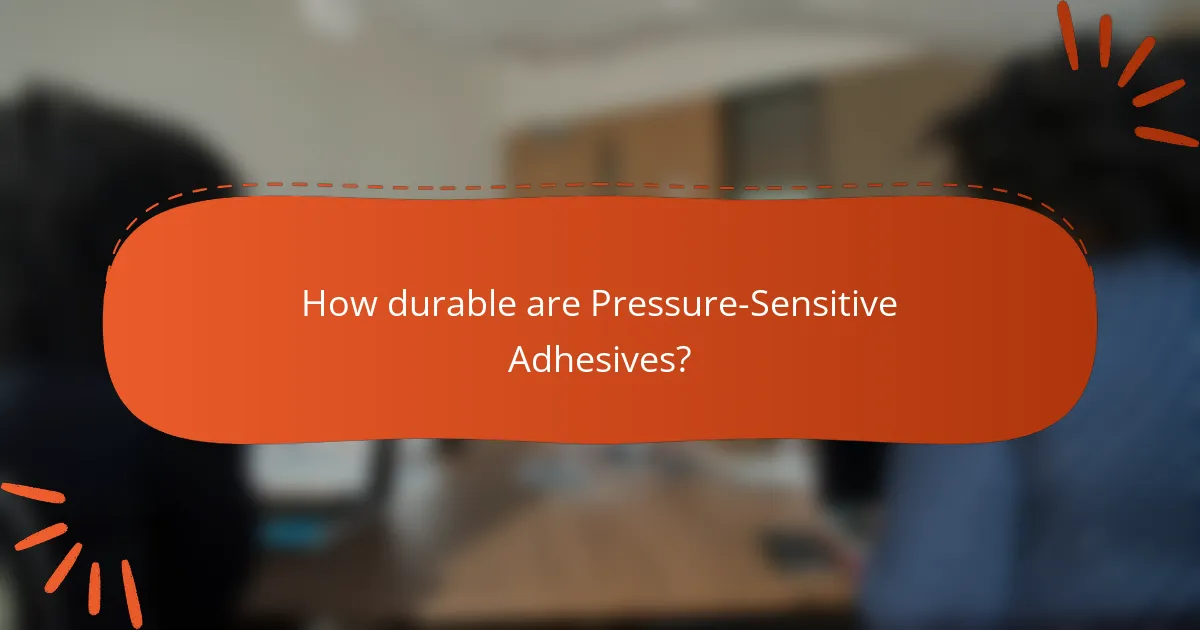
How durable are Pressure-Sensitive Adhesives?
Pressure-sensitive adhesives (PSAs) exhibit varying durability based on their formulation and intended application. Generally, PSAs can provide strong bonds under a range of environmental conditions. Their durability is influenced by factors such as temperature, humidity, and exposure to chemicals. For instance, some PSAs are designed for temporary applications and may lose adhesion over time. Others are engineered for long-term use and can last for years without significant degradation. Research indicates that high-quality PSAs can maintain adhesion for over five years in optimal conditions. Therefore, the durability of pressure-sensitive adhesives is contingent upon their specific formulation and environmental factors.
What factors determine the durability of Pressure-Sensitive Adhesives?
The durability of pressure-sensitive adhesives (PSAs) is determined by several factors. These include adhesive composition, substrate materials, environmental conditions, and application techniques.
Adhesive composition affects the bond strength and resistance to aging. Certain polymers provide better durability than others. Substrate materials influence how well the adhesive adheres. Smooth and clean surfaces enhance durability.
Environmental conditions such as temperature and humidity play a critical role. High temperatures can weaken adhesive bonds over time. Humidity can also affect the adhesive’s performance and longevity.
Application techniques are vital for ensuring optimal adhesion. Proper pressure and alignment during application improve durability.
Research shows that PSAs with specific formulations can withstand more stress and environmental challenges. For example, studies indicate that acrylic-based adhesives generally offer superior durability compared to rubber-based ones.
How do environmental conditions impact adhesive longevity?
Environmental conditions significantly impact adhesive longevity. Factors such as temperature, humidity, and exposure to UV light can degrade adhesive performance. High temperatures can accelerate the aging process, causing adhesives to lose their bonding strength. Conversely, low temperatures can lead to brittleness and reduced flexibility. Humidity levels affect moisture absorption, which can weaken adhesive bonds over time. UV light exposure can break down adhesive polymers, leading to discoloration and loss of adhesion. Research indicates that adhesives exposed to extreme environmental conditions have a shorter lifespan. For example, studies show that adhesives in high-humidity environments can lose up to 50% of their bond strength within a year.
What are the signs of adhesive failure over time?
Signs of adhesive failure over time include visible delamination, reduced bond strength, and surface discoloration. Delamination occurs when layers separate, indicating a loss of adhesion. Reduced bond strength can lead to peeling or lifting at the edges. Surface discoloration often signals chemical degradation of the adhesive. Other signs may include bubbling or wrinkling, which suggest moisture infiltration. These indicators can arise from environmental factors like temperature fluctuations and humidity. Regular inspection can help identify these signs early, allowing for timely remediation.
How can the durability of Pressure-Sensitive Adhesives be tested?
The durability of Pressure-Sensitive Adhesives (PSAs) can be tested through several standardized methods. These methods include peel tests, shear tests, and aging tests. Peel tests measure the adhesive’s ability to withstand separation forces. Shear tests evaluate the adhesive’s resistance to sliding forces. Aging tests assess how environmental factors affect adhesive performance over time.
In peel tests, a specified force is applied to remove the adhesive from a substrate. The force required to peel the adhesive indicates its durability. In shear tests, a weight is applied to the adhesive bond, measuring the time it takes for failure to occur. Aging tests often involve exposing the adhesive to extreme temperatures or humidity.
These testing methods are outlined in standards such as ASTM D3330 and ASTM D1000. These standards provide guidelines for accurately measuring the performance of PSAs under various conditions.
What standardized tests are used for durability assessment?
Standardized tests used for durability assessment include ASTM D3359, ASTM D4541, and ASTM D1004. ASTM D3359 evaluates adhesion through a tape test. ASTM D4541 measures the bond strength of coatings. ASTM D1004 determines the tensile strength of films. These tests provide reliable metrics for adhesive performance under various conditions. Each test follows strict protocols to ensure consistency and accuracy. They are widely recognized in industry standards for evaluating material durability.
How do real-world conditions affect test results?
Real-world conditions significantly affect test results for pressure-sensitive adhesives. Factors such as temperature, humidity, and surface cleanliness can alter adhesive performance. For instance, high humidity can lead to moisture absorption, impacting adhesion strength. Temperature fluctuations can change the viscosity of the adhesive, affecting application and cure times. Surface contaminants can prevent proper bonding, leading to unreliable test outcomes. Studies show that testing adhesives in controlled environments yields different results compared to real-world conditions, emphasizing the need for practical testing scenarios.
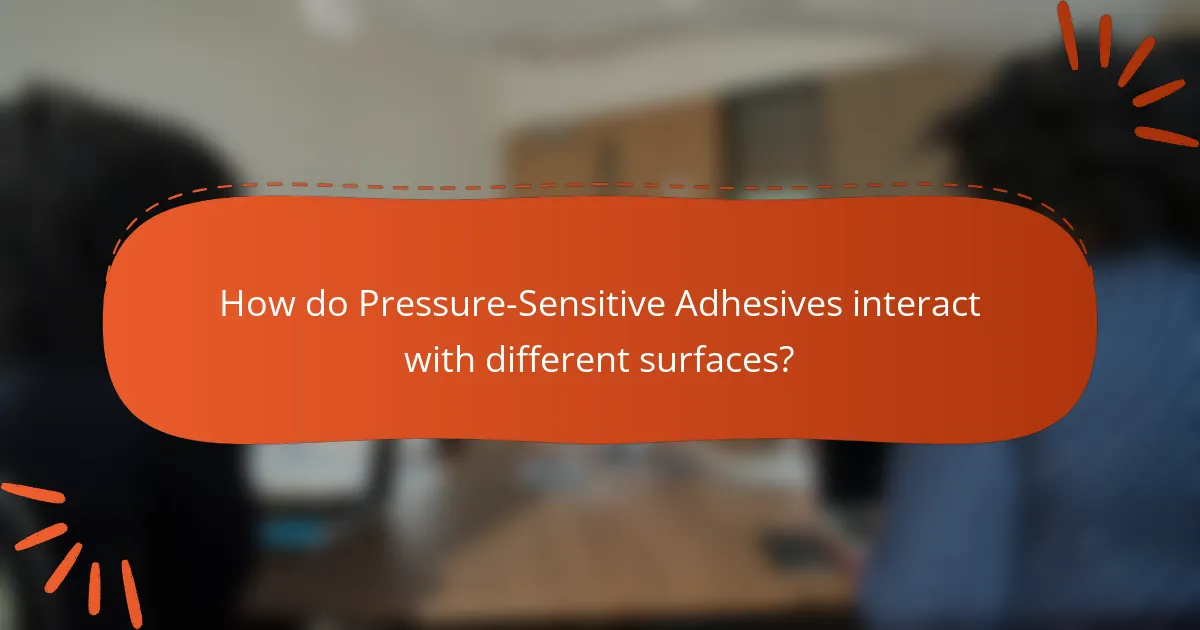
How do Pressure-Sensitive Adhesives interact with different surfaces?
Pressure-sensitive adhesives (PSAs) bond to surfaces through a combination of adhesion and cohesion. They interact differently based on surface energy and texture. High-energy surfaces, like metals, provide strong bonding due to increased molecular interaction. Low-energy surfaces, such as polyethylene, may require surface treatments for effective adhesion. The surface roughness also affects bonding; rough surfaces can enhance mechanical interlocking. Additionally, PSAs are formulated to optimize performance on specific substrates. For example, acrylic-based PSAs offer good adhesion on a variety of surfaces. Studies show that proper surface preparation enhances adhesive performance significantly.
What surfaces are compatible with Pressure-Sensitive Adhesives?
Pressure-sensitive adhesives are compatible with a variety of surfaces. These include metals, plastics, paper, and wood. Each surface type requires specific adhesive formulations for optimal bonding. For example, smooth surfaces like glass and polished metals work well with these adhesives. Textured surfaces may require adhesives with higher tack for effective adhesion. Additionally, porous surfaces like cardboard and untreated wood can absorb adhesive, affecting bond strength. Testing adhesion on specific materials is recommended to ensure compatibility.
How does surface texture affect adhesion?
Surface texture significantly affects adhesion by influencing the contact area between surfaces. A rough surface increases the mechanical interlocking of adhesive materials. This interlocking enhances the bond strength. Conversely, a smooth surface may limit the adhesive’s ability to grip effectively. Research shows that adhesives perform better on textured surfaces due to increased surface area. For instance, studies indicate that a surface with a roughness average (Ra) of 1-3 micrometers can improve adhesion by up to 30%. Therefore, optimizing surface texture is crucial for maximizing adhesive performance.
What are the challenges with non-porous surfaces?
Non-porous surfaces present specific challenges in adhesive applications. These surfaces often lack the ability to absorb adhesives effectively. This can lead to poor adhesion and reduced bond strength. Non-porous materials may also require surface preparation for optimal adhesion. Cleaning and priming may be necessary to enhance bonding. Additionally, non-porous surfaces can be sensitive to temperature fluctuations. This sensitivity can affect the performance of pressure-sensitive adhesives. Lastly, certain non-porous materials may release contaminants that hinder adhesion.
What are the best practices for ensuring surface compatibility?
The best practices for ensuring surface compatibility involve thorough surface preparation and material testing. Begin by cleaning the surface to remove contaminants such as dust, grease, and moisture. Use appropriate solvents or cleaning agents based on the substrate material. Next, assess the surface texture and porosity, as these factors influence adhesive performance. Conduct adhesion tests on sample surfaces to determine compatibility before full application. It is also crucial to select the right adhesive type based on the materials involved. For example, some adhesives work better on plastics, while others are suited for metals or composites. Following manufacturer guidelines for application techniques and curing times enhances compatibility. Finally, monitor environmental conditions such as temperature and humidity, as they can affect adhesive performance.
How can surface contaminants be effectively removed?
Surface contaminants can be effectively removed using appropriate cleaning methods. Common techniques include solvent wiping, scrubbing, and using specialized cleaners. Solvent wiping involves applying a solvent to a cloth and rubbing the contaminated area. Scrubbing utilizes a brush or pad to dislodge contaminants. Specialized cleaners are formulated to target specific types of contaminants, such as oils or adhesives. Research indicates that using the correct cleaning agent enhances adhesion performance. For example, a study published in the Journal of Adhesion Science found that surface preparation significantly improved the bond strength of pressure-sensitive adhesives.
What tests can be conducted to ensure compatibility?
Compatibility tests for pressure-sensitive adhesives include peel adhesion tests, shear strength tests, and thermal cycling tests. Peel adhesion tests measure how well the adhesive bonds to a surface when force is applied. Shear strength tests evaluate the adhesive’s ability to resist sliding under load. Thermal cycling tests assess the adhesive’s performance under varying temperature conditions. These tests help ensure that the adhesive will perform effectively in its intended application. Proper testing is crucial to prevent failure in real-world conditions.
What are common troubleshooting tips for Pressure-Sensitive Adhesives?
Common troubleshooting tips for pressure-sensitive adhesives include ensuring proper surface preparation. Clean surfaces free of dust, oil, and moisture enhance adhesion. Test adhesion on a small area before full application. Adjust application pressure to achieve optimal bonding. Ensure the adhesive is within its specified temperature range during application. Store adhesives according to manufacturer recommendations to maintain effectiveness. If adhesion fails, consider the material compatibility of surfaces. Finally, check for expiration dates on the adhesive to ensure it is still usable.
How can users address adhesion failures?
Users can address adhesion failures by ensuring proper surface preparation. Clean surfaces remove contaminants that hinder adhesion. Users should also select appropriate adhesive types for specific materials. Testing adhesion on a small area can identify potential issues early. Adjusting application techniques, such as pressure and temperature, can improve bond strength. Monitoring environmental conditions during application is crucial for optimal adhesion. Regular maintenance and inspection of bonded surfaces can help detect failures early.
What maintenance practices can prolong adhesive performance?
Regular cleaning of adhesive surfaces can prolong adhesive performance. Dirt and contaminants can weaken adhesion. Use a suitable solvent or cleaner to remove residues. Ensure surfaces are dry before reapplying adhesive. Proper storage conditions also enhance adhesive longevity. Store adhesives at recommended temperatures and humidity levels. Avoid exposing adhesives to extreme temperatures. Regular inspections can identify early signs of failure. Addressing issues promptly can prevent further degradation. Following these practices helps maintain optimal adhesive performance.
Pressure-sensitive adhesives (PSAs) are versatile bonding agents that adhere to surfaces upon the application of pressure without the need for heat or solvents. This guide covers the various types of PSAs, including acrylic, rubber, and silicone, along with their key components and how these influence adhesion properties. It also explores best application techniques, factors affecting durability, and how PSAs interact with different surfaces, providing insights into effective use across industries such as automotive, electronics, and packaging. Additionally, the guide offers troubleshooting tips and maintenance practices to enhance adhesive performance and longevity.
